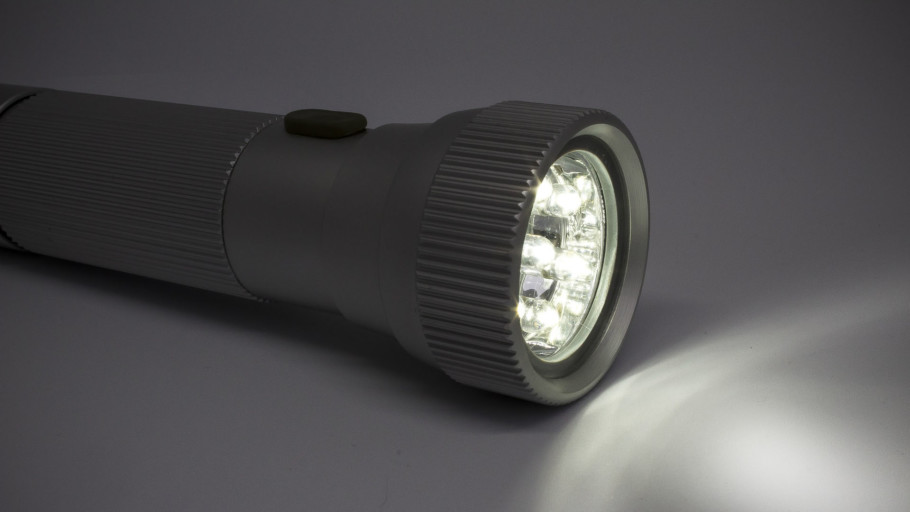Rechargeable Flashlights: We Shine a Light on the Best
Flashlights are essential, especially if you like to camp or hike in the great outdoors, but what do you do when the batteries die? You could take a supply of fresh batteries with you, but that would be expensive and bad for the environment. Instead, you could invest in a rechargeable flashlight.
Rechargeable flashlights come in all shapes and sizes, from the small, pocket-size varieties that are ideal for hunting and outdoor pursuits, to the gun-style searchlights that you would keep around the house for emergencies. Whatever your use, buying a rechargeable flashlight is an excellent investment. Which ones are the best? We shine a light on on the pros and cons of 5 rechargeable flashlights to help you decide which one is right for you.
- 900 lumens
- 1,000 ft. reach
- 5 adaptable settings
- Water resistant
- 18-month warranty
- 2-Pack with 1,000 and 2,000 lumens
- 5 light settings
- 8-hour runtime
- Water resistant
- 7-year warranty
- 1,000 lumens
- 5 light modes
- Zoom function
- 600 ft. range
- 1-year warranty
- 2,600 ft. range
- 6,000 lumens
- 20-hour runtime
- Doubles as a smart device charger
- 1-year warranty
- 900 lumens
- 10-hour runtime
- Lithium-ion battery
- 5 light modes
- 1-year limited warranty

This Anker Tactical flashlight has a reach of over 660 feet, which is the length of 2 football fields; with the zoom feature, that range can be extended to roughly 1,000 feet.It comes with a 3350mAh battery that will last for 6 hours when used on the medium beam setting, and the LED bulbs will last up to 5,000 hours. This little flashlight is rugged, with an IP65 rating for water resistance that means it is designed to be used in heavy rainfall, and the body is fashioned from durable aluminum to make it shockproof and perfect for rough handling.
This flashlight takes 6 hours to reach maximum recharge capacity, so make sure that you give yourself time before you set off on any long trips. It comes with a mini USB charging cable, however, so you can feed the battery while you are driving if your car has a USB port. On the downside, though, it only comes with a USB charging cable and not the 1A adaptor for charging indoors. In addition, Anker claim that the flashlight will stand on end as an emergency light, but that is only possible without the wrist cord attached. The 5 light modes can also be confusing as you have to scroll through each one until you get to the one you want.
Pros
- Water resistant
- Maximum 1,000 ft range
- USB port for in-car charging
- 6-hour runtime
Cons
- 6-hour recharge time
- Doesn’t come with the adaptor
- The light mode settings can be confusing to find
This Peak Plus set comes with 2 flashlights: one with 2,000 lumens and the other with 1,000 lumens.The smaller of the two weighs in at less than a quarter of a pound, with the larger tipping the scales at less than half a pound, so they are lightweight as well as robust. Both come with zoom control to adjust the brightness and focus the beam for greater distance reach.
Unlike the Anker Super-Bright Flashlight with its 6-hour battery life, the larger flashlight in this 2-piece set has a maximum of 8 hours runtime, while the smaller model has a 5-hour capacity, so they should see you through the night. These flashlights are also highly resistant to water, so they’ll keep working regardless of what the elements throw at you. It has 5 light settings, from strobe to S.O.S, and because the main body of the torch is constructed from hard wearing aluminum, it won’t corrode in wet conditions.
On the downside, the build quality of both these flashlights and their charger is questionable. Moreover, while these products are bright, some have questioned Anker’s claims that they have 1,000 and 2,000 lumens, respectively.
Pros
- Great price for a 2-piece set
- Lightweight and robust
- Maximum of 8 hours runtime
- Water resistant
- 7-year warranty
Cons
- Build quality issues
- Question marks over the lumen claims
- Flimsy charger feels cheaply made

This Peak Plus flashlight comes with a protective carry-case to keep it safe from harm and can run either rechargeable batteries or more conventional varieties so you never run out of power. It has a zoom feature with 5 settings, from x1 to x2,000, that gives you the option of a wide beam to illuminate the area around you or a focused beam for greater positioning and an extended 600-foot range. These features mean that this is a tremendous pocket-size flashlight that would be ideal on hunting, camping, and hiking trips.
Again, like all the others featured in this list, it has an aluminum alloy shell to stop it from corroding in the wet, but what makes this flashlight different is that it uses Lithium-ion batteries, which give you an extended runtime. On the downside, Lithium-ion batteries are notoriously fickle when it comes to the temperatures, so don’t expect this flashlight to be as reliable in sub-zero chills. Furthermore, when the battery runs low, it could take up to 12 hours to reach a full charge. Now we understand why there is the option of using ordinary batteries with this model.
Pros
- Lithium-ion battery
- Made from robust aluminum
- 5 zoom settings
- Water resistant
- Also runs on standard batteries
Cons
- The temperature can affect Lithium-ion batteries
- Long recharge time
This CSNDICE flashlight offers a super-powerful 6,000 lumens and a beam reach of over 2,600 feet. It really is a searchlight and the brightest flashlight on the list, and if you couple its luminosity with the fact that the Lithium-ion battery gives a massive 9,000mAh, it should stay illuminated for up to 20 hours. If you place the flashlight in the low mode setting, you could extend that runtime to 24 hours.
This light is rain resistant and robust with a large handle located on the top and a durable, shock resistant body. The aspect that makes this LED searchlight unique, though, is that it doubles as a smart device charger, with a USB port located at the base. You needn’t worry about excessive overcharging or discharging because it has built-in protections.
On the downside, this flashlight is on the large side, which doesn’t make it that mobile, especially if you are trekking, or hunting and need something more discreet. As an aid for emergencies, though, it is handy to keep the trunk of your car. In addition, this flashlight won’t stand on its own as it lacks any flat surfaces, so using it as a nightlight in a tent is going to be a challenge. Finally, be warned: this flashlight is so bright that it might keep your campsite up at night.
Pros
- 6,000 lumens
- Maximum runtime of 24 hours
- Doubles as a smart device charger
- Lithium-ion batteries
- Water resistant
Cons
- Bulky shape means it’s best suited for the home or the car
- Lacks any flat surfaces so falls over easily
- It may be too bright for camping purposes
Stanley is a well-respected name in the tool and DIY sphere, so it stands to reason that they should produce a flashlight that is worthy of this review. This SL5HB model is the first pistol-grip variety, meaning it is ergonomic and comfortable to use. Couple that with the lockable trigger switch, which allows you to operate it hands-free, and it really is child’s play using this thing. It’s bright too, with 900 lumens, delivered by a 5w LED.
The Lithium-ion battery will hold a charge for up to 12 months once it is fully charged but idle, and when in use, it will operate for a maximum of 10 hours continuously. It also comes with both AC and DC charging facilities so you can keep the battery fully charged wherever you are.
On the downside, like the CSNDICE LED Searchlight, this is a flashlight suited for emergencies around the home or in the car, and not likely to be of use in the great outdoors like the Anker Super-Bright Flashlight, so it isn’t as versatile. The charging cord is also a frustrating mini USB plug, so over time the connection will deteriorate. Finally, when the light is on for any lengthy period, the bulb gets really hot.
Pros
- Comfort grip
- Trigger switch
- 900 lumens
- Lithium-ion battery
- The battery hold a charge for 12 months when not in use
Cons
- Fiddly charging cable and port
- The bulb gets extremely hot after sustained use
Comparison Chart
| FEATURES | Anker Super-Bright Flashlight | MS Force Tactical Flashlights | Peak Plus Flashlight | CSNDICE LED Searchlight | Stanley SL5HB Flashlight |
| Lumens | 900 | 1,000/ 2,000 | 1,000 | 6,000 | 900 |
| Beam Reach | 1,000 ft. | 1,000 ft. + | 600 ft. | 2,600 ft. | Approx 600 ft. |
| Runtime | 6 hours | 8 hours | 7 hours | 20 hours | 10 hours |
| Lithium Battery | X | X | ✓ | ✓ | ✓ |
| Light Settings | 5 | 5 | 5 | 2 | 5 |
| Price | $$ | $$ | $ | $$ | $$ |
| Weight | 6.24 oz | 0.95 lbs | 0.72 lbs | 1.25 lbs | 1.6 lbs |
| Dimensions | 6.22 x 1.57 x 1.57 | 11 x 2.5 x 12 | 5.3 x 1.6 x 1.1 | 7.7 x 4.1 x 4.1 | 8.6 x 4.1 x 8.3 |
| Warranty | 18-month | 7-year | 1-year | 1-year | 1-year |
Buyer’s Guide:
Rechargeable Flashlights
Final Thoughts
Be it in the home or the wild, a rechargeable flashlight is your best buddy, but if you require something for a specific task, then look at each of the attributes of your flashlight. For a camping trip you might sidestep a pistol-grip version for something more useful, like the Anker Super-Bright Flashlight. It will meet your needs perfectly, because it has a durable aluminum casing, 900 lumens, a maximum 1,000 feet range, and best of all, is super-lightweight.
The Peak Plus Flashlight is the clear favorite, though, if you have a limited budget because it has all the features of others on this list but costs a lot less. If you want a flashlight that will give you the maximum amount of light, and the CSNDICE LED Searchlight leads the pack with a massive 6,000-lumen bulb that has a reach of 2,600 feet. Whatever you choose, remember that rechargeable flashlights are also good for the environment, because it means you don’t have to toss spent batteries in the trash every time you go hiking.









